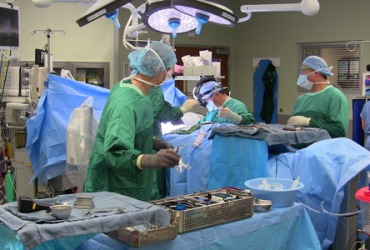Degenerative
Microsurgical Treatment of Lumbar Disc Herniation: A Report of 158 Patients with a Mean Followup of More Than 32 Years.
- Burkhardt BW, Grimm M, Schwerdtfeger K
- SPINE | 44 (20) | October 2019

This is a retrospective review of reported outcomes of 158 patients, with a minimum of 25 years followup after microsurgical discectomy of a lumbar herniated disc.
The Authors conclude that microsurgical discectomy surgery is an effective technique with high patient satisfaction.
This is an important retrospective long term view on microdiscectomy, and certainly is consistent with the experience of most clinicians.
The challenge of identifying patients, and obtaining a personal followup and clinical examination is significant.
1775 consecutive files of patients who underwent de-novo surgery was identified. The authors randomly contacted every fifth of these patients. 355 patients were selected. Of these 355, 43 had either died, or could not be contacted.
Of the 312 contacted, 30 were mentally or physically neither able to fill in the questionnaires, or not able to attend the clinical examination. 124 were not interested in participation.
158 (50.6%) of the 312 participated in clinical followup in the clinic for inclusion in the followup data.
Data collected included factors such as radicular pain, back pain, motor weakness, sensory dysfunction, functional outcome and working status.
Data included use of pain medication, sports activities, and return to work.
Clinical success was based on MacNab criteria.
All patients who had additional lumbar surgery were asked to provide documentation related to the additional surgical procedures.
The final data analysis revealed 70% of patients had return to normal sensation. 70% reported no pain medication use. 68% reported no physical limitations. 89% report good to excellent functional recovery.
47 (30%) patients report additional lumbar surgery. 6 (13%) report additional surgery related to the original microdiscectomy surgery. One person had a traumatic event that required repeat spine surgery. 40 of the 47 patients had additional surgery secondary to degenerative disease.
Regarding patients (40) who had additional surgery for degenerative disease, 11 of these patients had recurrent HNP on the ipsilateral level. 5 had recurrent HNP on the contralateral side. 9 had discectomy for a cranial level. 11 had discectomy for a caudal level. 4 had repeat lumbar decompression for spinal stenosis or facet inflammation.
Reviewing the Data on Patients who had repeat surgery, only one of the 47 total patients had fusion surgery.
This is a fantastic look at a very specific population who had microdiscectomy surgery more than 25 years ago. Like all retrospective studies there are challenges. Unfortunately, the demographics of the patients who did not respond to the call, or declined the study was not discussed. The demographics of the orginal 1775 patients who had microdiscectomy surgery was not discussed. In addition, the surgical level of the microdiscectomy was not identified.
Overall a very interesting review of a common surgical procedure. The clinical satisfaction over 32 years is encouraging for patients. The minimal use of lumbar fusion surgery in this population may suggest the microdiscectomy technique may reduce the need for future stabilization.


Comments (0)
Note: We honor your privacy and will not disclose or share your email address with any third-party. Your email address will not be published, and is only used for the purposes of replies and notifications pertaining to these comments.